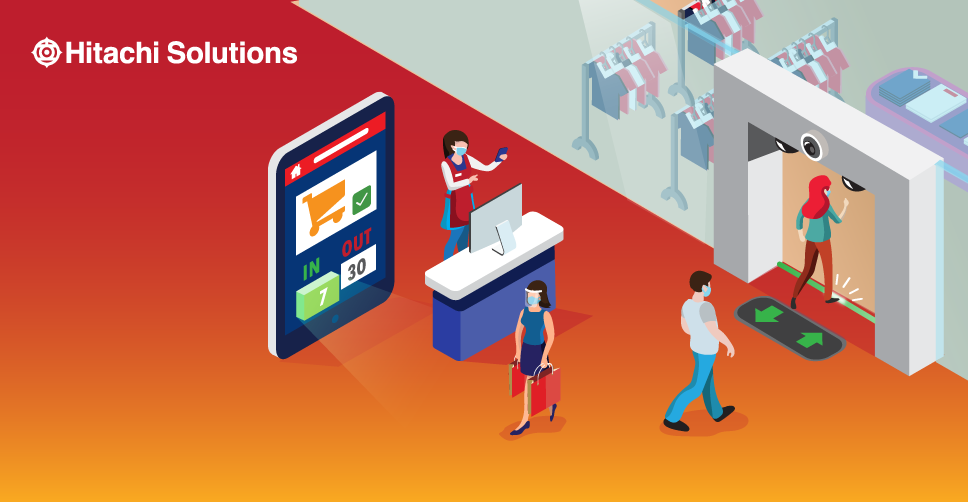

To combat the spread of COVID-19, the Centers for Disease Control and Prevention (CDC) has advised limiting face-to-face contact through social distancing, the practice of maintaining at least 6 feet of distance between you and other people.
While these measures are necessary to control the virus, retailers and other businesses that choose to reopen to the public are now forced to re-evaluate many of their current practices; most notable is the need to limit occupancy to prevent large groups of people from gathering. But how can retailers effectively monitor and control traffic without sparing other resources?
Read on to explore the options, including the benefits of an automated system for both present and future retail operations.
How Retailers Can Set Capacity Limits
Many states have already set public use guidelines and capacity limits for places like grocery stores, retail stores, and other businesses. To protect employees and customers and comply with local regulations, retailers generally have two ways to control traffic: limiting capacity to a certain number of people per square footage or by percent of occupancy.
Here’s how this works: Big-name retailers like Walmart now regulate store entry to no more than five customers per 1,000 square feet at a time, or 20% of a store’s capacity. Once the limit is reached, entry is allowed on a “one-out-one-in” basis. In a more radical example, Calvert County, Maryland, implemented voluntary guidelines that limited shopping trips to 1 every 5 days, with the first letter of a shopper’s last name dictating their specific shopping date.
How Are Retailers Managing Capacity Limits?
Setting a limit on the number of people allowed in a store at any given time is just the first step. Enforcing a capacity limit requires a deep analysis to determine what is most feasible for your business.
As retailers navigate COVID-19 limitations, there are two primary tactics for managing traffic flow:
Manual People Counters
Many retailers are assigning the people counting process to their employees. The employee uses their mobile device, a pen and paper, or a manual counter to keep track of the people coming in and out of the building.
While this is a quick solution, it’s not without its downfalls. For one, this requires an employee to be at the entrance of the store at all times, instead of inside stocking the shelves or running a register. There is also always the chance for human error, as it can be easy to get distracted and lose count of people on a busy Saturday.
Automated People Counters
The most advanced solution is to deploy automated people counters for 24/7, real-time traffic and occupancy monitoring. These counters utilize IoT solutions like sensors, thermal devices, and video technology to keep track of and control the flow of people throughout brick-and-mortar operations, thus complying with CDC recommendations on occupancy limits.
Infrared sensors at entry points count how many times a beam breaks to determine occupancy. Video-based counters use 3D imaging to monitor traffic, and thermal people counters measure a person’s body heat as they enter a building. With a thermal device, if a person enters a store and the camera detects that they have a high temperature, a custom workflow can be triggered that alerts both management and the customer. In the age of COVID-19, this can be a useful technique to prevent the spread of the virus.
The Benefits of Automated People Counters
Automated people counting systems are connected to the internet and all data is transmitted to a software application. With this connectivity, these devices are able to do far more than just count people. Here are just a few of the many benefits:
- Maintain accurate, real-time tallies. Complying with state and federal regulations is key to containing the spread of COVID-19. Automated counting devices keep accurate tallies without the threat of human error.
- Integration with existing systems. Automated people counting devices can integrate into your existing business systems and platforms, such as CRMs, ERPs, business intelligence, and other tools.
- Alert management when specific conditions are met. When maximum capacity is reached or when someone with a high body temperature enters the store, custom workflows and notifications can alert the proper people to handle the situation.
- Analyze information to understand trends. As trends change on an almost daily basis, identifying peak shopping hours is crucial to ensure that you have the right number of employees per shift.
- Track movement throughout the store. With one-way traffic the new normal for most stores, understanding the flow can help you set up merchandise and promotions in the right places. It can also help you prevent bottlenecks in certain areas. For example, if you’re noticing that shoppers are congregating around pool supplies, maybe you can spread out this section to other areas of the store for the duration of the summer.
- Temperature control. With the IoT, people counters can analyze weather conditions and adjust indoor temperatures as necessary. If it’s raining, building occupants may not be eating their lunches on the outdoor patio, and your system can adjust the temperature of the indoor cafeteria to maximize comfort for the additional diners. This can also optimize utilities with automatic adjustments based on the amount of people in the building.
Getting Started with Automated People Counters
Achieving the benefits of an automated people counting system begins by implementing a robust IoT platform. The right technology driven solution will serve as a foundation for all data collection and analyses, in addition to facilitating workflows and communicating with your other integral business systems.
Hitachi Solutions helps businesses design, implement, and manage their IoT platforms to ensure that data is accessible and ready for analysis. With the insights gained from constant data collection and routine evaluation, retailers can strategize competitive ways to offer personalized shopping experiences while remaining compliant with COVID-19 regulations. For more information about how we can support your IoT platform, contact one of our specialists today.


